Are you a Quiet Speculation member?
If not, now is a perfect time to join up! Our powerful tools, breaking-news analysis, and exclusive Discord channel will make sure you stay up to date and ahead of the curve.
Welcome to the second edition of Beginner's Guide, the article series where we help Standard players make the transition to Modern. Two weeks ago I talked about the importance of choosing and then mastering your deck. This week we discuss sideboarding, easily the hardest and most essential part of Modern.
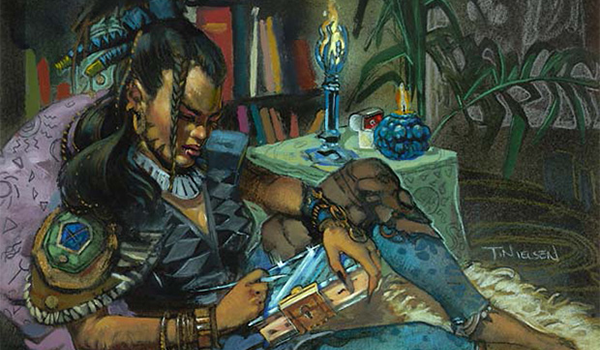
In my experience, players moving from playing Standard exclusively to try out Modern struggle to win a game for their first half-dozen tournaments. The first few come down to unfamiliarity and inexperience. It's one thing to playtest and to watch Modern coverage to figure out how a deck plays and what you can expect from other decks. It's entirely another to figure out for yourself how to navigate a removal-light hand against Infect, or how to correctly sequence your shocklands against Burn when under attack by a Goblin Guide so you don't just lose. There is a learning curve and it can be quite steep.
The later struggles can usually be traced back to deckbuilding errors, especially sideboard decisions. Maindecks are already challenging enough to build because small changes can have enormous consequences, but it is a solvable puzzle. Generally speaking, a given deck has certain cards that you need to play all the time, the only question being proportions. And that can be figured out through the deck testing process and adjusted based on your playstyle without harming your deck.
[wp_ad_camp_1]
The Standard Player's Problem
The same cannot be said of the sideboard. Make a mistake and it will cost you, either because your strategy was wrong or because you ignored a matchup that you shouldn't have. Now, every Modern player does this periodically. The format is too open and too volatile to get it right all the time. What differentiates the more experienced Modern player from a Standard convert is how deck positioning and sideboarding are perceived. Standard sideboards are usually about fine-tuning maindecks while in Modern it's about repositioning to change how the matchup functions.
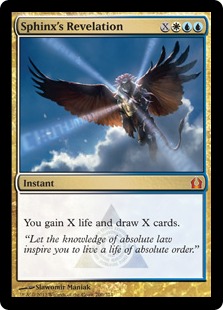 Let me explain. As I said last time, over the past few years Standard has centered around a relatively small number of powerful, format-defining cards such as Thoughtseize, Sphinx's Revelation, Thragtusk, and Siege Rhino. (Rally the Ancestors was a deviation from this pattern, which we'll get to below.) The trick for deckbuilders has been to determine which of these staples are best positioned at any given time, and which of the less powerful roleplayers to pair with them.
Let me explain. As I said last time, over the past few years Standard has centered around a relatively small number of powerful, format-defining cards such as Thoughtseize, Sphinx's Revelation, Thragtusk, and Siege Rhino. (Rally the Ancestors was a deviation from this pattern, which we'll get to below.) The trick for deckbuilders has been to determine which of these staples are best positioned at any given time, and which of the less powerful roleplayers to pair with them.
The best decks have the best support for these power cards, and the best answers to opposing ones. The result is a pile of midrange good-stuff decks. The sideboard becomes an extension of the maindeck, where all you're really trying to do is shift to better answers to a specific power card. In other words sideboarding in Standard revolves around answering cards, not strategies. For the most part you aren't dramatically altering your deck or trying to change gears but simply adjusting your support cards so that you can continue to do your powerful thing and prevent the opponent from deploying theirs.
While trying to do that can work in Modern it's likely to be less optimal than simply playing win-the-game cards in your sideboard. If you accept the idea that Standard is about the most recent power cards, then Modern is all the power cards from all of the Standards since Mirrodin. As such the total power level is much higher and spread out over more cards. With this flatter power level across archetypes and individual cards, trying to support a few generic haymakers to overpower the opponent doesn't work as well.
Yes, there are decks that do that, namely BGx, but these decks also contain the defining aspect of Modern decks: internal synergy.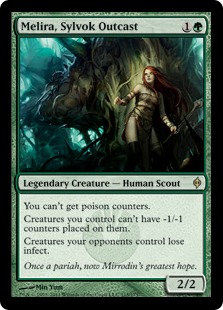 All the pieces may be individually powerful, but put it together and the whole is much greater than the sum of its parts. Thoughtseize and Tarmogoyf are very powerful individually, but they're much better together. Thoughtseize proactively protects Goyf and provides an average of two power for it, while Goyf provides the pressure that ensures Thoughtseize's disruption stays relevant. Abzan Company plays a reasonable fair game of creature-based beatdown but put the right reasonable creatures together and you have an instant win.
All the pieces may be individually powerful, but put it together and the whole is much greater than the sum of its parts. Thoughtseize and Tarmogoyf are very powerful individually, but they're much better together. Thoughtseize proactively protects Goyf and provides an average of two power for it, while Goyf provides the pressure that ensures Thoughtseize's disruption stays relevant. Abzan Company plays a reasonable fair game of creature-based beatdown but put the right reasonable creatures together and you have an instant win.
The recent dominance of Rally in Standard much closer resembles the situation in Modern. Rally had some individually powerful cards but when combined with sacrifice outlets and graveyard recursion made a deck that was far greater than any of its individual components. What this means for sideboarding is that you can't just try to tweak your deck because the internal synergy and power of the opposing deck will allow it to overcome refining changes. You also need to consider that the opponent will be sideboarding against you, bringing in answers for your answers or even their own disruption.
Given that the power of sideboard cards is much higher in Modern than in Standard, you can't rely on fine-tuning to win you games two and three. You need to be more drastic.
Choosing Sideboard Cards
You need to have a good reason to put a card into your deck, be it in Standard or Modern. When you put a card into a Standard sideboard and are challenged a perfectly acceptable 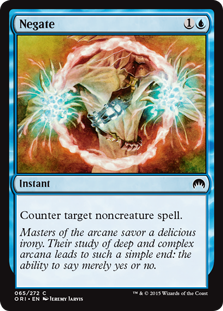 answer is, "It improves my matchup against <deck>" or "It answers <card> in <matchup>." In Modern that's not good enough for most decks. If I ask you why a card is in your Modern sideboard, your response should be, "If unanswered it beats <deck>," or "It's my out to <card that beats you>." A Modern deck should have as many "I win" cards in its sideboard as possible. Powerful options that make that possible exist, so you should be playing them. Trying to eek out small advantages isn't good enough. Yes, Negate may have a lot of applications out of your sideboard but it's never The Best Option.
answer is, "It improves my matchup against <deck>" or "It answers <card> in <matchup>." In Modern that's not good enough for most decks. If I ask you why a card is in your Modern sideboard, your response should be, "If unanswered it beats <deck>," or "It's my out to <card that beats you>." A Modern deck should have as many "I win" cards in its sideboard as possible. Powerful options that make that possible exist, so you should be playing them. Trying to eek out small advantages isn't good enough. Yes, Negate may have a lot of applications out of your sideboard but it's never The Best Option.
Alternatively you need cards that keep you from just losing to these hate cards. Affinity plays Wear // Tear not because it beats other decks (though it can under some circumstances) but because it keeps them from losing to Stony Silence. If all your card does is incrementally improve a game one matchup, it is detrimental to winning games two and three. Play higher-impact cards.
The Big Misconception
The biggest complaint about Modern, typically heard just before the Pro Tour, is that there's not enough sideboard space and it's impossible to prepare for the format because it's too big with too many decks. This is both true and untrue. Yes, Modern has a much bigger cardpool with far greater diversity than Standard. Our Top Decks page has eight decks listed as Tier 1. That's nearly as many archetypes as see play in Standard in total. Plus another ten in Tier 2, and seventeen in Tier 3. In Standard it is possible to have strategies and dedicated sideboard slots for each deck. That isn't possible in Modern.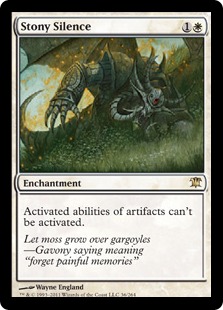
What isn't true is that you cannot prepare for the format or be ready for any deck. The truth of the matter is that there is considerable overlap between decks in terms of both their axes of attack and what they're vulnerable to. Look back at those Top Decks. How many decks utilize the graveyard? How many are vulnerable to artifact hate? Night of Souls' Betrayal?
The simple fact is that you can and should play cards that are very good in certain matchups and then have applications against a wide variety of decks. Stony Silence is one of the best cards around against Affinity and Lantern Control and also cripples Tron and the Thopter combo. In Modern, you don't want to target specific decks very often. You're better off targeting strategies and resources.
The Rules
When new players ask me for sideboarding advice I always give them some general guidelines to follow. I should stress that these are just guidelines and they don't apply to every deck. But I've found they apply often enough to function as a good starting point. They break down into two categories: specific card selection and matchup preparation.
Card Selection Rules
Beyond my already stated admonishment to only play the best cards, I have one rule and a corollary for sideboard cards.
1. Play cards that are good whenever you draw them.
Modern isn't Legacy---you can't dig for your cards with lots of cantrips. It is not unlikely that you will never actually see any sideboard cards in your opening hand or at all. Therefore 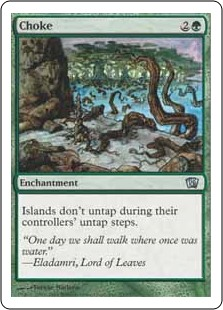 relying on cards that are only good in your opening hand is not a winning strategy. Some players will advocate mulliganing to hit your hate cards but the odds decrease each time you do that (unless you're Jordan with his Serum Powders), and after the first mulligan it's unlikely to be worth it.
relying on cards that are only good in your opening hand is not a winning strategy. Some players will advocate mulliganing to hit your hate cards but the odds decrease each time you do that (unless you're Jordan with his Serum Powders), and after the first mulligan it's unlikely to be worth it.
Instead play sideboard cards that will be helpful and impactful on both turn one and ten because you may not see them until late in the game. This will let you keep more reasonable hands and prevent you from drawing dead cards in the late game.
1a. If you absolutely need it, play four.
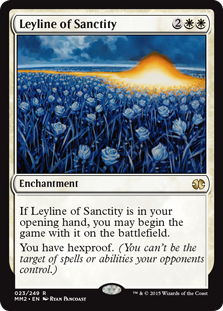 Unless, of course, you will lose the game if you don't have the card. In that case you need to maximize your chances of drawing it, particularly in your opening hand. Cards like Leylines and Chalice of the Void are exponentially worse to draw than they are to see in your opening hand, so if you really need them to not lose (say Bogles with Leyline of Sanctity against Jund or Merfolk with Hurkyl's Recall against Affinity) you need to play a full set. This takes up a lot of space in your board, but if it's a matchup you expect to see a lot it will definitely be worthwhile. Hopefully the four-of has applications in other matchups to make its presence less burdensome.
Unless, of course, you will lose the game if you don't have the card. In that case you need to maximize your chances of drawing it, particularly in your opening hand. Cards like Leylines and Chalice of the Void are exponentially worse to draw than they are to see in your opening hand, so if you really need them to not lose (say Bogles with Leyline of Sanctity against Jund or Merfolk with Hurkyl's Recall against Affinity) you need to play a full set. This takes up a lot of space in your board, but if it's a matchup you expect to see a lot it will definitely be worthwhile. Hopefully the four-of has applications in other matchups to make its presence less burdensome.
Matchup Selection Rules
This section covers my rules for what matchups to specifically prepare for. Remember, you should try to have general sideboard cards that hit a lot of matchups, but you should focus on a few that you know you'll hit a lot to maximize your chances of winning. My rules, from most to least important:
1a. Don't concede to Affinity.
Affinity is a good deck. It will be present at every tournament of PPTQ level or higher and you 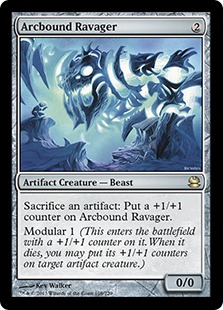 are likely to face it at least once. If your maindeck plan isn't very good against Affinity then you must have sideboard slots allocated to defeating the deck. There is a lot of hate available against the deck, and it is very effective. Don't just lose. You can beat the robots.
are likely to face it at least once. If your maindeck plan isn't very good against Affinity then you must have sideboard slots allocated to defeating the deck. There is a lot of hate available against the deck, and it is very effective. Don't just lose. You can beat the robots.
How many hate cards depends on your deck. Jeskai Control's maindeck is good enough against Affinity that it doesn't need to play more than a card or two. Ad Nauseam can largely ignore the deck and might only run a few ways to protect itself from Affinity's sideboard. Merfolk on the other hand has a terrible game-one matchup and so needs to dedicate a lot of space, but as a reward it has a much better overall matchup. The deck is beatable as long as you prepare for it, so do so.
1b. Don't concede to Dredge.
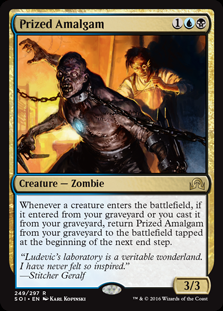 Until a month ago this was just a holdover from Extended, and was the point that I was most willing to negotiate on or drop entirely. Then players figured out that Prized Amalgam was good and now I'm holding firm: Play graveyard hate!
Until a month ago this was just a holdover from Extended, and was the point that I was most willing to negotiate on or drop entirely. Then players figured out that Prized Amalgam was good and now I'm holding firm: Play graveyard hate!
You shouldn't concede to Dredge for the same reasons as Affinity: The deck loses to hate cards, and these hate cards are also good in other matchups. It's easy to fit a few Relic of Progenitus into any deck, so just make sure that you aren't cold to this deck. Scavenging Ooze is an okay maindeck answer, but it's easy to overwhelm. Have some hate and beat that deck, and improve your Grixis matchup while you're at it!
2. Win close matchups.
The place where sideboard choices can be most impactful are the close matchups. When game one is 50/50, you will need every edge to win games two and three. You don't want to go overboard, but make sure that you have what you need to win the game. You're not likely to see your matchups where you're 65%+ to win or lose all that often compared to your close matchups so spend the sideboard space to either keep it close or outright win.
3. Don't lose good matchups.
Arrogance and overconfidence are the downfall of more players than anything else. Just because game one is really good for you doesn't mean the match will be. As I've said before there are very powerful sideboard options available for all decks in Modern. Your good matchup knows they're weak to your deck and will have something that can turn things around. Either pack an answer or your own "I win" button to make sure your good matchup stays good. You have no excuse to give away percentage points, so spend the slots.
4. Win bad matchups (if they're winnable).
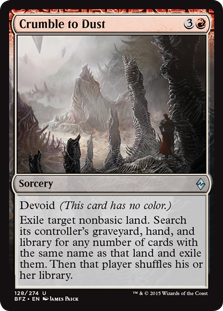 Look, there are decks out there that you can't beat. This is Modern---no matter your chosen archetype, there's bound to be a matchup you're 20% or less to win. Even if you had fifteen slots for that deck you're still only 50% to win. (If not then you're Eldrazi and on your way to the banlist.) In these cases there's no point trying to beat the deck---your best bet is to focus on other decks and hope to dodge.
Look, there are decks out there that you can't beat. This is Modern---no matter your chosen archetype, there's bound to be a matchup you're 20% or less to win. Even if you had fifteen slots for that deck you're still only 50% to win. (If not then you're Eldrazi and on your way to the banlist.) In these cases there's no point trying to beat the deck---your best bet is to focus on other decks and hope to dodge.
However, there are also decks where you may only be 40% to win game one, but with the right sideboard cards you shift to 60%. GR Tron is a huge favorite to win against Jund game one, but if in game two Jund has Fulminator Mage and Crumble to Dust it has a huge advantage. Don't fight hopeless battles, but if you can beat it out of the sideboard without giving up other matchups then you should absolutely try to win.
You Will Learn With Time
If that seemed like a lot to take in, it was. And I'm skipping over a lot of nuance and subtlety about overlapping hate and preboarding some kinds of hate cards. However this article series is intended as a general guide to help new Modern players adapt and learn the format. Check back next week for a more detailed guide to sideboard cards and the maindecking question.
Is there anything you think I've missed? Do you have additional questions as a new player? Are there questions you wish someone had answered when you were new? Let me know in the comments and I'll do my best to answer them as this series progresses.





Huh. I was just saying in the comments of yesterday’s article that I’ve temporarily given myself a rule of running no more than 2 copies of any given card in my sideboard, thus forcing myself to find multiple weaknesses in opposing decks and simultaneously to identify cards that can be effective against multiple decks. Thus, I end up with a sideboard containing 8-10 different cards (some singletons, some pairs), with each matchup making use of 2-4 of them in overlapping groups.
This may not be a good “endpoint”, but it’s certainly been helpful for me to get started.
“Don’t concede to Dredge” is a hard rule of building a sideboard in Modern? Why? I’d argue that it’s not important for format newcomers to have very narrow hate for one deck hovering between just 0.4 and 0.6% of the metagame. “Don’t concede to Affinity” is fine, since that deck is a known quantity and regularly hangs closer to 10%. But your inclusion of Dredge as a bullet point here makes me question this article’s success at its stated goal: to help newbies understand Modern and subsequently prepare competent sideboards.
The reason you give for not excluding Dredge hate from the sideboard:
“It’s easy to fit a few Relic of Progenitus into any deck, so just make sure that you aren’t cold to this deck.”
That’s just not true. A lot of decks DO struggle to fit a pair of Relics in their sideboards, which is why we don’t see Relic in that many sideboards. If it was so easy, more players would do it. But it’s not easy — instead, it costs precious slots that could be dedicated to decks that hold more than a single metagame percentage point, as opposed to ones that hold less.
Yeah, I was a little curious about that too. Maybe the author’s LGS has lots of dredge for some reason?
The point he was making is that you should pack some kind of graveyard interaction–it’s a bullet against some decks, and useful against most to some extent or another.
My personal rules for sideboarding in ALL nonrotating formats:
1. There is always a “dredge deck” of some kind in the format and you should have hate. Sometimes it plays Bazaar, sometimes It plays cranial plating, sometimes it’s goblin charbelcher. There’s a linear cannon deck that operates on a different axis from everybody else, and you can play hate for it, and you can win the matchup. Don’t leave the hate and expect other people to hate out the cheese deck.
2. Play graveyard, artifact, and enchantment interaction. This format has a large card pool, and your opponent could be doing all sorts of noninteractive shenanigan things. Most tricksy things involve using artifacts, enchantments, or the graveyard, so having SOME amount of interaction with each of these zones/permanent types is important.
3. Understand what the disruption is in the format (thoughtseize? Force of Will? Mental Mis-Step?) and have sideboard plans that line up favorably against these interaction points (flashback spells/cavern of souls/2 drop creatures).
4a. If Lich is legal in the format, some bonzo in the GP is playing it in their mainboard, and you will be paired against them round 1. I might or might not be 3 for 3 on this statement being true at legacy GP’s.
4b. If Lich is not legal in the format, that bonzo is playing modern enchantment prison, you’ll get paired against them round one, and they will curve out in such a way that you question why this deck isn’t tier one because it clearly has every possible angle covered.
Michael Warme has it right. Graveyard hate is good against a lot of decks, and Dredge is increasing in popularity online and in paper, so while you should have had it before to combat Grixis, Living End, and Abzan Company now you really need it or you risk losing to Dredge.
The rule came about because back when Extended existed every few weeks Dredge would suddenly win a lot of tournaments because players hated it out then got complacent and took out their hate. I made sure to always have hate so that when that surge inevitably happened I was ready. While Dredge decks have always been around in Modern (Aggro Loam has been a frequent ‘surprise’ deck in the Colorado metagame for years now) we’re seeing a dramatic increase since Shadows came out, so once again it’s essential to have the means to beat that deck.
You distinctly ignored my rule 4, aka the Lich rule. Why does everyone ignore the Lich rule?
Well, mostly because that sounds like something very specific to you, Michael. I think there’s a general point to be made about GP’s bringing the weirdos out of the woodwork and to be ready for literally anything, but Lich? I think this may just be you taking one for the team, and I thank you for that (I don’t want to play against Lich or Pillow Fort round one).
I disagree that you should always have hate for .06% of the format. This is not Extended. Every format follows its own sideboarding rules.
I feel like the idea behind the rule is to make sure you have some form of graveyard hate, and dredge just makes a good poster boy for the concept. As you know, modern does have a lot of graveyard interactions between goyf, snapcaster, delve, and many others. It only makes sense to pack hate for these interactions when such good hate exists.
Are you going to be covering transformational sideboards next week hopefully?
Among other things, yes. When the Beginners Guide version doesn’t cover everything I’ll follow up the week after with the more advanced tips and tricks.
Here’s my issue – there aren’t really blowout cards against Jund and a few other decks. I feel like every deck I play is soft to Jund (even Tron postboard!) and there’s no Crumble To Dust effect that just puts them away. The only card I found that they cannot beat is Elspeth, Sun’s Champion, but that’s six mana. You’ve not only got to play a deck that can live long enough to cast it, you’ve got to have the mana on board to make it happen. In decks that can’t run it, I’m stuck with things like Celestial Purge and hoping to flash it back with Snapcaster Mage. If there are blowout cards I’m missing, please let me know!
What you’re saying is true, but that’s also generally true of any completely fair midrange deck regardless of format. It’s arguably GBx’s greatest strength and the reason to play the deck. You’re definitely not on the deck because its 50% vs almost everything. In my experience the best way to cripple Jund in particular has been mana denial. Spreading Seas and Tectonic Edge really put the screws to the deck though they’re not the blowout wins that you may want. Frankly, since it sounds like you’re on a control deck I think that you’re best bet is Sun Titan recurring value creatures and Tec Edge to simply grind Jund out rather than looking for bullets, since they really don’t exist.
I’ve been trying something out, but I’m not convinced that it is theoretically sound, and would like your opinion. By the time I have finalized my sideboard, I have made a list of the 20 decks that I expect to be most common with their expected percentage. I make a sideboard plan for each deck and use a spreadsheet to add up all the changes. (this card comes in for this deck that is 10% of the meta, add 0.1 to its value. That card comes out for the deck that has 8% of the meta, subtract 0.08 from its value). I swap the sideboard card that comes in the most with the mainboard card that comes out the most, and see if the total number of sideboarded cards is reduced. If it is, I keep the change. This has given me a deck with 4 or 5 “sideboard” cards in the maindeck, and a sideboard where 4 or 5 cards are the third or fourth copy of a maindeck card, that come in for decks for which they are especially relevant. The idea is being criticized because you will too often have dead cards, when the “sideboard” doesn’t match the opponent game one. My thinking is that the cards that come in are broadly effective, on average more effective than the cards they replace, and only rarely less effective, in which case they come out. There are also the unexpected benefits, like the time my Naya Burn opponent exclaimed in surprise, “You play Blood Moon mainboard?”. I squeaked out a game one win, and he ended the game with an unplayable Boros Charm and Atarka’s Command, either of which would have killed me. Game 2 I replaced the Blood Moons with an Etched Champion and a Chalice of the Void, but the Blood Moon had not been a dead card.
My approach has been pretty universally rejected, and I am not a very good player, so I don’t have great stats to recommend it, although my personal win percentage has improved. However, none of the colleagues can give me the numbers based explanation as to why this approach is a bad one. I was hoping that you might be able to provide a numbers base explanation as to why this either works, or doesn’t.
I’m going to start off with a pair of disclaimers:
1) In any scientific inquiry if theory and experimental results conflict then it is the results that are correct. If your method is working for you, and working noticeably better than the more conventional methods then by all means continue. As part of this I should note that my only evidence about your method comes from your description so if I’m missing some nuance or detail that’s why.
2) I’m going to be going to be talking about maindecking sideboard cards and preboarding in my next article, so if you think I’m missing some detail about those it’s because I’m saving it for Tuesday.
In theory there is validity to your method. Playing broadly effective maindeck sideboard cards can be very effective. Using data analysis and spreadsheeting as you describe is fairly common (I think Frank Karsten has written about something similar a few times) and it can be effective. The problem is that it is very easy to get too “in the weeds” and lose sight of the big picture. It sounds like you’re playing Affinity so let me ask you how much your method is impacting your goldfish? Maindecking sideboard cards in the numbers you’re describing in aggressive decks is dangerous because you can dilute your gameplan too much. If you’re bringing in and maindecking a lot of cards I have to assume that you’re also taking out the support cards for the maindeck plan. Too much of that and suddenly your maindeck plan doesn’t work anymore. If you’re removing Affinity’s usual flex cards (almost always Galvanic Blast these days) I have to ask whether on average the ability to goldfish faster would have been better than a card that buys you time in some matchups.
I cannot see your data to give you a definitive numbers based explanation, but I can say that the questions you have to answer are about overspecialization and opportunity costs. Does playing more specialized cards that are targeted at certain matchups but have some play elsewhere give better percentage across the board than playing a card that has the same value regardless of matchup? Say you have one card whose value, on a scale of 1-10, is 8 against certain decks and 3 against everything else. The card you are thinking of replacing for is consistently a 5.5 regardless of matchup. The question you have to answer is whether you will get the 8 enough, with its +2.5 payoff, enough to justify the -2.5. I don’t know the answer for you, but you will need to answer it for yourself if you want to keep using your method.
As for your specific method I have questions about your procedure that makes me question the validity of your results. As described your methodology is too complex and inconsistent. Why are you adding value on 10% and subtracting value on 8%, and why is that value equal to the percentage? That appears to be too complex and arbitrary for really valid analysis. I would suggest, based on my education and experience, that you should choose a baseline percentage, for my purposes here the middle of Tier 1’s range (5%), set that equal to zero and base your scoring off of that number. In my system, using the data from our Top Decks page as I’m typing this, Jund would be 3.7 (8.7%-5%)while Affinity would be -.4 (4.6%-5%). It doesn’t matter where you put the baseline (the dividing line between Tier’s 1 and 2 may be better) as long as you have one and use it consistently. This may give you a very different picture of the meta and your sideboarding decisions than your current method but it would also be more consistent numerically.
I hope this helps, and if you have more questions either ask here or see if I cover them on Tuesday.